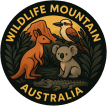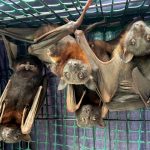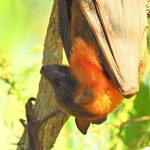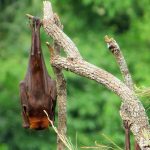LITTLE RED FLYING FOX
Little Red Flying-fox (Pteropus scapulatus)
As the light softens over a river red gum forest, the air warms and carries a sweet, honeyed scent of eucalypt blossom. A soft rustle builds to a velvet roar, and a ribbon of shapes lifts from the trees—thousands of little red flying-foxes rising as one. Their wings catch the last gold of sunset, glowing a warm amber through the thin membrane. You hear their chatter—sharp, excited notes—and feel a gentle push of air as they pass overhead, setting off across the night to trace the nectar bloom.
These are the pollinators of the night shift, stitching together forests with every flight.
At a glance
| Feature | Details |
|---|---|
| Scientific name | Pteropus scapulatus |
| Common name | Little red flying-fox |
| Size | Wingspan ~1 metre; body length 16–21 cm; weight 300–600 g |
| Appearance | Rusty-red to chestnut fur; often paler shoulders; large eyes; translucent wings |
| Range | Northern and eastern Australia: WA (Kimberley/Pilbara), NT, QLD, NSW, into northern VIC, and occasionally SA |
| Status | Protected; generally not threatened (locally vulnerable to heatwaves and habitat loss) |
| Specialisation | Highly nectar- and pollen-focused; major long-distance pollinator of eucalypts and paperbarks |
| Social life | Forms very large “camps” (hundreds of thousands); roosts in dense clusters |
| Young | One pup per year; births mainly November–January |
Identification
- Coat is reddish-brown to coppery, with lighter fur across the shoulders (the species name
scapulatusmeans “shouldered”). - The wings are thin and often appear pinkish or amber against light.
- Smaller and more lightly built than other Australian flying-foxes, with a fine, fox-like face and large, dark eyes.
- Often roosts packed together on slender branches, creating “grape-like” clusters—typical of this species.
Similar species:
- Grey-headed flying-fox: grey head with a russet collar; larger overall.
- Black flying-fox: mostly black with a dark mantle; larger and heavier.
- Spectacled flying-fox: pale “spectacle” rings around the eyes (far north QLD).
Range and habitat
- The most widespread Australian flying-fox, following flowering events across northern and eastern Australia.
- Prefers camp sites near water—river red gums, melaleuca wetlands, and mixed eucalypt woodlands.
- Camps can appear suddenly when eucalypts, paperbarks, or banksias are in heavy bloom, then disperse as flowering wanes.
Life and behaviour
- Nocturnal; leaves camp at dusk in streams that can look like “flying rivers”.
- Uses keen eyesight and a strong sense of smell to find blossoms—flying-foxes do not use echolocation.
- Camps are social and noisy, with a musky, sweet scent from blossoms and roosting bats.
- In hot weather, they fan with their wings, pant, and lick their wrists to cool; extreme heatwaves can be fatal.
Nightly movements:
- Can travel tens of kilometres from camp to forage, tracking the freshest nectar.
Diet and ecological role
- Diet is dominated by nectar and pollen from:
- Eucalypts (including river red gum, ironbark, bloodwood)
- Paperbarks (Melaleuca)
- Banksia, Grevillea, and bottlebrush
- Occasionally feeds on soft native and introduced fruits when nectar is scarce.
Why they matter:
- Exceptional long-distance pollinators. By moving pollen between widely spaced trees, little reds keep eucalypt forests genetically connected and resilient.
- Their seasonal movements help link habitats across vast landscapes—especially after rain-driven flowering events.
Breeding
- Generally one pup per female each year.
- Mating typically occurs autumn to early winter; births mainly November to January (timed to peak summer flowering).
- Mothers carry pups for the first few weeks, then leave them in “creche” trees within the camp during nightly foraging.
- Pups begin flying at around 2–3 months and wean by 5–6 months.
- Lifespan can exceed a decade in the wild.
Threats
- Heat stress and extreme heatwaves, which can cause mass mortality.
- Loss of flowering and roosting habitat through land clearing and urban development.
- Entanglement on barbed wire and unsafe fruit tree netting; electrocution on powerlines.
- Disturbance at roosts, especially during late pregnancy and pup-rearing.
- Food shortages in drought years may push bats into orchards, increasing conflict.
Health note:
- Flying-foxes can carry viruses harmful to humans if bitten or scratched. The risk is extremely low if you do not handle them. Only trained, vaccinated wildlife carers should rescue or handle bats.
Living alongside little reds
- Never handle a bat. If one is injured or on the ground, contact your local wildlife rescue group.
- Use wildlife-safe netting on fruit trees: choose white, UV-stable netting with a small mesh (≤ 5 mm) and pull it taut.
- Avoid barbed wire near flowering trees; replace with plain wire where possible.
- Keep pets indoors at dusk and dawn, particularly near known camps or flowering trees.
- Plant native nectar species (e.g., eucalypts, melaleucas, banksias, grevilleas) to support natural foraging.
- Give roosts space—especially in summer and during pup season—to prevent deadly stress.
Quick facts
- Camps can number from a few hundred to well over a hundred thousand individuals.
- Their brush-tipped tongues are designed to sweep nectar and pollen efficiently.
- In flight, their wings make a soft, rhythmic “fwap”, and large dusk departures can sound like distant surf.
- They are fully protected native wildlife across Australia.
A closing scene
By midnight, the forest hums quietly. Blossoms glisten with dew, and a dusting of pollen coats petals like fine gold. The little reds move tree to tree, invisible threads stitching the night together. When dawn blushes the river, they drift home, bellies full of nectar, carrying the next forest in the pollen on their fur.





